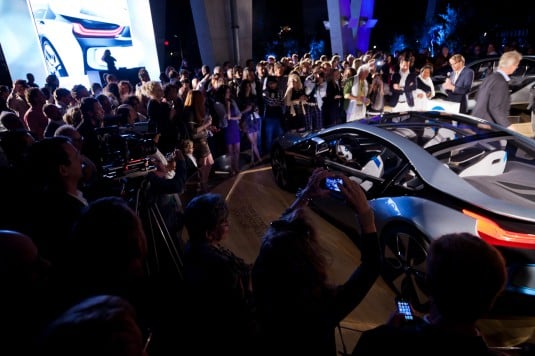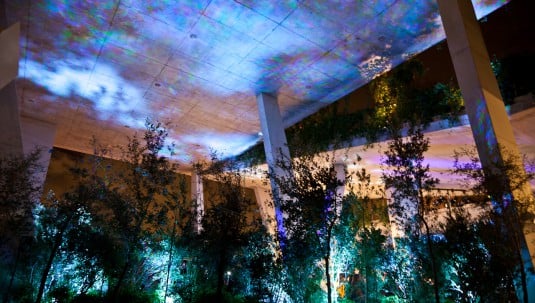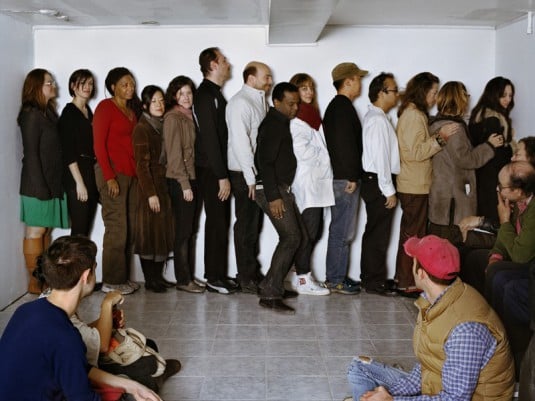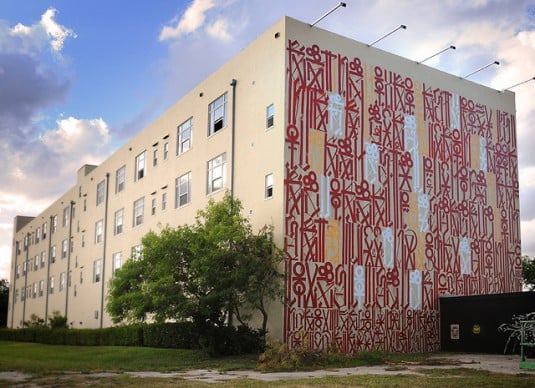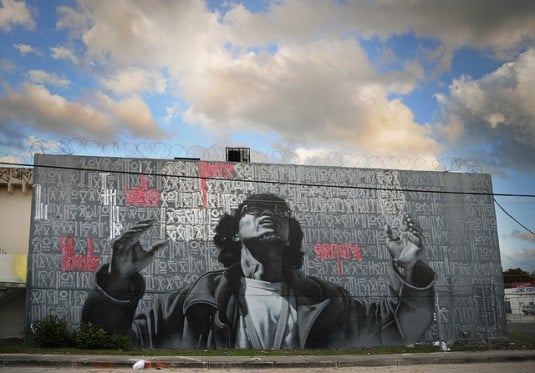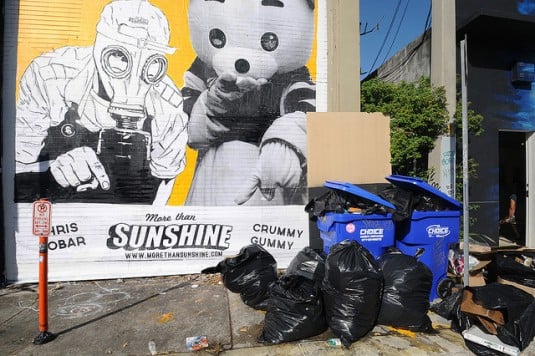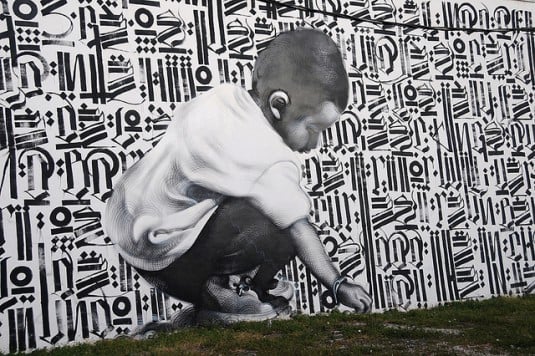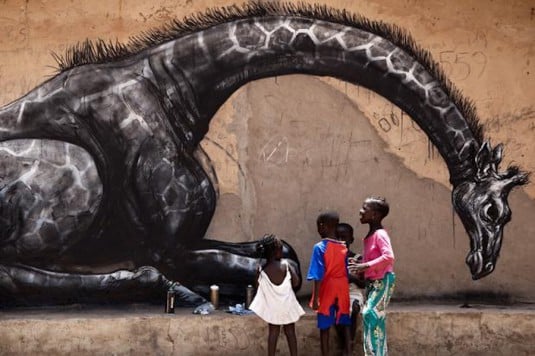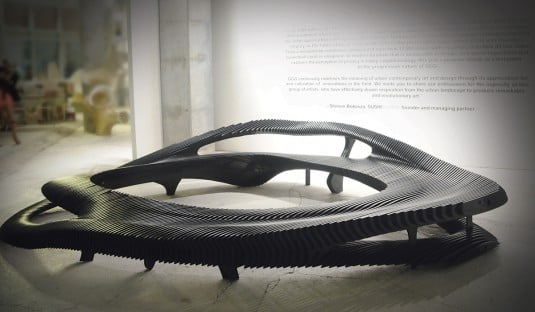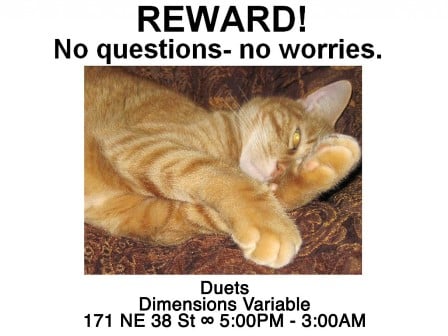
December 15, 2011
Better Art for Better Living
Jonny Robles It was just another bright day in uptown Miami Beach, when the first art movers loaded in paintings to the 1950’s Morris Lapidus golden “Temple of Curves,” The Deauville Resort, for the Nada art show in preparation for Art Basel/Design Miami Beach. The neighborhood shop attendants at Rite Aid, Pizza Hut and bodegas, […]
Jonny Robles
It was just another bright day in uptown Miami Beach, when the first art movers loaded in paintings to the 1950’s Morris Lapidus golden “Temple of Curves,” The Deauville Resort, for the Nada art show in preparation for Art Basel/Design Miami Beach. The neighborhood shop attendants at Rite Aid, Pizza Hut and bodegas, adorned with murals of neon flamingos that morphed into sexy girls, took their cigarette and mobile breaks and quietly watched the event unfold. Would they even enter the show?
Imagine your town. Imagine a gold dusting and buzzing of high stakes international art dealers, collectors and celebrities drawn to the honey of private dinners, streets teaming with pilgrims jumping from alcohol to car and fashion brand-sponsored events, mobile phone touring teens and hipsters running through former industrial areas where hooded and masked international graffiti writers sprayed their messages on 2- story cranes. Later, higher still, sunset cocktails were downed above the city lights at a private launch of BMW’s new electric car in an open-air conceptual parking lot, now an architectural icon. This, my fellow citizens of Anytown Earth, is what they call a community of global art.
Art Basel Miami Beach 2011 was 10years old this year. And this year, I was in search of more than the highest quality debauchery or the million-dollar manse or sale of art. I was curious about the usual urban blight to might trajectory of the influx, beginning with artists, residents, galleries, small business, big business, big entertainment, tourist buses, sky-high real estate boom, and sometimes ending with monoculture. How has and how does this once-a-year party infuse its host community with art, culture and future? Does Better Art make for Better Living?
Raymond Pettibon, No title (But the sand…)
For centuries, waves upon waves of communities have washed ashore in Miami, from the first small band of Paleo Indians, the conquesting Spaniards, the unwilling African slaves, the fleeing Cuban refugees, the South Americans, Northern snowbirds, and real estate investors, most driven by commerce rather than art, into its bleached white fortresses lining the beaches. Which leads me to ask, What is Miami today and what will it be in 10 years or 20? When Art Basel’s public performers packed up their tents and the rat-pack jet-set strapped themselves into their first class seats headed to the next party, will something have changed in the community when it settles back into just another bright Miami day?
I spied some promising signs of enlightened discourse between the state of our world, community and art, as I saw it in the experiment that is Miami Beach.
FOR BETTER LIVING: ARTFUL TRANSPORT
Eighty-dollar round trip taxi fares to MOCA Museum in North Miami for the opening night Vanity Fair party left one feeling both depressed and full of vanity. It was much more fun and of much lower impact to ride a DecoBike , Miami’s very affordable rental share bike program. I loved the freedom, free exercise, and happily joined the locals loving the liberation from tons of steel, high gas prices and parking nightmares.
Miami, though a condo-centric car culture, is leading stateside in picking up the Euro bike trend, aiming to become a “Bicycle Friendly City by 2012.” In fact, as an outcropping of the Friday and Saturday mass Art Walks and open galleries, Miami is going one step further with its “Miami Critical Mass” a group bike ride with as many as 1,000 riders, with no agenda other than fun and community, open to all cyclists on the last Friday of every month.
The G-Spot Bike Tour, put together by beachedmiami.com for the Get the Green Light, G-Spot Art Project was Art Basel’s vigorous spectator sport, beyond party-attending. This mobile urban intervention, an art concept with community as a distinct ingredient, evolved from past decades of sit-ins, happenings, and flash mobs. The tour, sponsored by European Lager brand, Grolsch. took troopers on a scavenger hunt to find 10 interactive and site-responsive murals and installations featuring 10 local Miami artists, throughout different locales in the Design District, Wynwood, and downtown neighborhoods.
The literal exercise, came complete with some brain push-ups via a panel called Psychogeography: Moving Through Miami, about a “range of interventionist gestures in Miami’s streets,” and included Tatiana Hernandez of the Knight Foundation, who calls it “creative placemaking” and says “social offerings, followed by openness and aesthetics explain why we love where we live.” The mission of the foundation’s Random Acts of Culture, is to “fund projects that enrich and engage communities…and bring a community together through spontaneous classical dance and music in eight U.S. communities.”
G-Spot Curator Claire Breukel, and curator to Miami’s Downtown Development Authority (DDA), which helped to source venues for the project, told us that the aim was to “Get the Green Light aimed at bringing Miami artists to the fore at a time there is an influx of international artists showing their work. As site responsive works in conversation with the landscape of Miami the work aimed to engage audiences in a way that was unexpected and ‘authentic’ to Miami.”
The art intervention of huge light and video tower displays of citizens proclaiming their wishes, such as “I want more green space,” among candlelit paths, lots of catered cocktails and canapés in South Beach’s SoundScape Park, the 2.5-acre green space facing the new Frank Gehry building for the New World Symphony, was the BMW Guggenheim Lab . This mobile multidiscipline laboratory of scientists and planners will travel to nine major cities worldwide over six years as a project of The Guggenheim Foundation to examine contemporary urban life. I ultimately wondered what the outdoor community cocktail party added to the project description and goal as “Part urban think tank, part community center and public gathering space,” other than this was Art Basel.
Much more substantial and influential was part two of the party, the launch of two very design-forward BMW electric cars unveiled in the open air Herzog de Meuron parking lot urban edifice along with 500 trees destined for the streets donated by Miami’s star architect Chad Oppenheim. Beautifully hosted by Dwell Media, the event soothed the ache for some consciousness among the flash of Art Basel and promised a little less ozone-depleting gasoline cocktails into the communal air.
I did wish that the party would have been run from solar generators all day and pondered the fact that our electricity still runs on oil, an outdated source of power for sundrenched locations. As one who grew up in the 1970’s and remembers the Keep America Beautiful PSA commercial of the Indian crying in the smog and little school essays written called, “Stop the Poltion [sic],” I sometimes feel that healthy change is taking too long to happen.
FOR BETTER LIVING: A COMMUNITY OF HUMAN, ANIMAL “PREDICAMENTS”
As we expand our definition of community to be more than humans, to include animals, nature, and the earth, the rise of art that melts the old rules and forges new ones is essential. The rise of audience- engaging performances increasingly “belongs” to a community as a shared experience. “Modern art is about our own culture….you are asked to become a participant become part of the art space…and as the audience, you are completing the artwork,” as Peter Boswell, Miami Art Museum’s Senior Curator explains.
Stand in front of the camera. Don’t blink. In Clifford Owens’s solo exhibition, Photographs with an Audience (Miami), at Gallery Diet in conjunction with NYC’s On Stellar Rays gallery the audience was the art. Compositions with the engaged audience become photographs, taken by the audience, then mounted on the gallery walls. By un-owning the art and labels such as “performance artist,” Owens orchestrates the unpredictable happenings, releasing of labels of artist, viewer, participant, control and re-inventing ideas of creative community.
Private is Public Art. Innovating with the public since the birth of ABMB and famed for hosting Spencer Tunick’s 2007 photo installation of 600 nude people on pink rafts, is the Sagamore Hotel’s ongoing dedication to the public sharing of a “private collection” art with its guests. New this year is curator Cricket Taplin’s second installation of art for the hotel’s staircases by collaborating student artists and the beach installation of William Ryman roses, whose first home was NYC’s Park Avenue, for the organically growing, community interactive and accessible art collection.
video by Mark Diamond, diamondimages.com
Animals are Us. Extending the idea of community beyond cozying-up, naked humans, the much talked-about co-habitation of unclothed artist Miru Kim in a glass walled gallery enclosure with two pigs saved from the slaughterhouse can be seen as groundbreaking territory, an evolution of Joseph Beuys’, I like America and America likes me, his 1974 action piece with himself in a space interacting with a live wolf. With a penchant for forgotten and unexplored places, Books Bischoff, curator of Primary Flight’s famed Wynwood Walls, is now breaking ground with Miru Kim for the expansion of our ideas of community itself, such as speciesism.
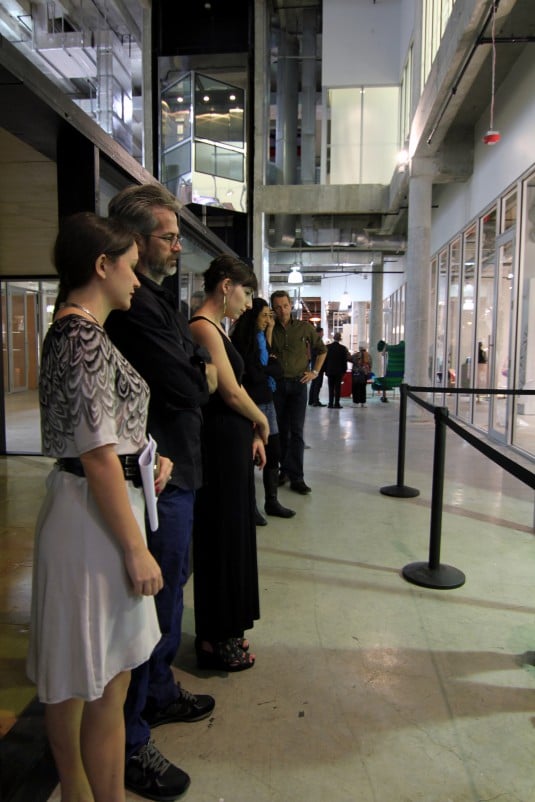 Miru Kim Primary Basel show 2011, Photo: Peter Vahan
Miru Kim Primary Basel show 2011, Photo: Peter Vahan
FOR BETTER LIVING: OCCUPY THE STREET WITH ART
Turning a corner to confront a painting of a massive dissected manatee the size of a warehouse and the thrill of knowing it was just painted the other day by internationally known artist, ROA from Belgium, was the visceral “still-wet” paint charge of an art-occupied street and a vote for art and community in one jolt.
“I am very comfortable saying, we changed the face of Miami,” asserted Books Bischoff, responsible for bringing together this image and more than 150 of the world’s most influential graffiti and street artists to install their bodies of work live, on industrial warehouses and walls in the streets of Wynwood, the Design District and greater Miami-Dade. Bischoff’s skillful negotiations with local drug gangs, residents, and police made all this happen without incident and led to later successful court proceedings to allow this community-led force of artistic expression.
If Primary Flight bought the street cred to Miami, it paved the way for art out of the galleries and into the street and on the beach. In previous years, New York’s Creative Time brought the party. This year on opening night, you could see Theaster Gates and the Black Monks of Mississippi and the Bass Museum hosting fair’s first event, an “Art Public” section, sculpture, and performances in Collins Park. But for spontaneous art and the community thriving because of it, art-proud Wynwood has solidly put Miami on the world map of important street art.
“The rich forever have had an obsession with the humble man making art, expressing what the rich are detached from. People have ended up fighting over this kind of thing since time immortal, raising the value of it like collecting little bits of souls,” Bischoff said of his championing of free expression in forgotten places and it‘s subsequent impact on values in real-estate and culture.
While artists own the copyright to their work, Miami’s powerhouse developers and art collectors offer the walls, go to court to fight for the right to paint and end up with valuable real estate, such as pioneers Jeffrey Deitch, Martin Margulies, and real estate developer Tony Goldman, who just launched a web series on the walls. And no surprise that the curator of this year’s most talked about shock-value Miru Kim’s exhibit, in a gallery space, was actually Primary Flight’s Books himself.
With calls such as, “Watch out for the pink sport vehicle,” we took an un-charted bike tour with local expert Dario Gonzalez, who works in urban planning for Florida International University and regularly leads these tours. Awed would be an understatement. To the music of downloaded car alarm tunes, laughing locals gathered for cookouts, hipsters and Nebraska moms on holiday gathered for spontaneous corner house DJ’s, we saw massive and precious works by the likes of Kenny Scarf, Shepard Fairey, Aiko Ryan McGinness, Friends With You, How & Nosm, Futura and Retna alongside scores of unknown, masked local crews and solo artisans working on walls. There is even a new art navigation app if Dario is busy that day with his day job at http://allcitystreetart.com/
Along with the pop-up vendors, food trucks, cool cafes and shiny sleek galleries, this year, appearing overnight, on the I-95 service road marking the Wynwood border to the west and continuing up onto the bleak and industrial buildings themselves, was a playful Dr. Seuss-like, absurdly drawn and numbered hopscotch with figures up in the 1,000’s. It reminded me of the lure the famed Miami Beach itself, with its curved wave footprints in the sand, trails of tiny sticks, shells and sea fare ticking off the measurement of time, goods and money which is transforming this happy soup of residents, international artists, and developers.
The good news is that the “occupy the streets” art movement is worldwide, involving and filling community members with hope and pride, from favelas getting a colorwash in Brazil to villages in Africa getting world-class artists involved for projects like Wide Open Walls, to JR, the 2011 TED prizewinner, who likes to call the street “the largest art gallery in the world.”
FOR BETTER LIVING: FEED+BUILD THE WORLD
Commissions and communications are the loom for community art, like Graffiti Gone Global, (GGB), an annual Art Basel event since 2007, led by Sushi Samba founder, Shimon Bokovza, a commissioner and supporter of street art.
Marc Fornes’s description of attitude of the temporary community of young kids coming together to help build his commissioned sculpture for GGG, Labrys Frisae, as “first curiosity, then pity, and then pride,” reminded me of Amish barn raising, cathedral building and alternatives to urban teenage rebellion and destructions. The community installation process took months to complete with its 12,000 unique parts and 100,000 connectors, becoming a huge coral-like structure you can actually enter. Sitting nearby and designed to foster community, Volkan Alkanoglu’s “urban device,” formed by two, infinite loops making a bench-like structure composed of opaque, high-density polyethylene, symbolized, as the designer said, “social interaction through its loops which are in constant dialogue.” Another evolving dialogue of the collection is the ongoing, permanent collection of Eames inspired chairs featuring street art, which now tours, by curator and artist, Billi Kid, as a centerpiece to GGG.
FOR BETTER LIVING: TAKE THE GAMBLE, BUILD IT, THEY WILL COME.
The art boom has influenced the city’s architecture boom as well. Dawntown, another project of DDA, the Knight Foundation, and the University of Miami School of Architecture, the annual, open to the public international architecture ideas competition brought innovative designs to neglected spaces of the city of Miami. This year local architect, Rene Gonzalez’s next project after designing the very fashion forward gallery/shop Alchemist is a community center servicing an elderly Latinos, inspired by early evening fireflies, while Brazilian design company, Ornare, hosted a panel that brought notable Miami and Brazilian-based architects and media together for “more than another cocktail party.”
One of the loudest architectural debates is actually Resorts International’s “3 billion dollar investment in Florida for the world’s largest casino” if they obtain one of the three licenses from the Florida Gaming Commission. Currently Seminole tribes run gambling resorts and there are slot machines at horse and dog racetracks, already making Miami Beach the US’s fourth largest gambling city. This time, both the Seminole and Disney oppose this new chapter in the city’s story, and the fundamental and developmental sea-change it portends.
Perhaps the search for true art, community and culture, is the peaceful economic and cultural co-habitation of artists, gamblers, investors, biologists, urban planners, and new immigrants seeking the American dream. As a very diverse community sharing the Earth, we now find ourselves with predicaments to manage complex issues versus problems with easy solutions, calling for conscious, creative, collaborative efforts to weave a truly whole new “Better Art for Better Living” experiment. Miami Beach’s Art Basel is one such experiment.
Images by Alvaro Montagna
Jade Dressler is a curator and consultant for consumer brands and private clients on art and design, from content to exhibits, from interiors to clothing collections and has a habit of spawning art interventions in far-flung locales like Portal do Sul on 10,000 acres in Brazil or urban Milan with the Green Provocateur project.






